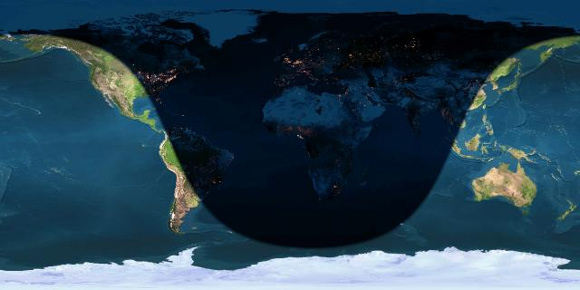The Winter Solstice

Day/night map of the earth at the 2014 Winter Solstice. Image credit: Earth and Moon Viewer
As a MN resident and a tolerate-r of winter, I am a big fan of the winter solstice. Once the solstice passes and winter “begins,” the amount of daylight begins to increase slowly heading us toward days with filled with more hours of sunlight.
Plenty of reason to celebrate in my book, but my visit this summer from my astronomer friend C got me wondering about this astrological phenom so I did some quick research.
- This year’s winter solstice will occur at 5:03 CST on December 21st. (The time is calculated mathematically as it would be “virtually impossible” to observe.
- Solstices are caused by the tilt of the earth on its axis (23.5˚) — not our planet’s distance from the sun.
- On winter solstices the northern half of the earth tilts away from the sun, on summer solstices, this hemisphere tilts toward it.
- The winter and summer solstices are “reversed” in the southern hemisphere. In other words, December 21st is the summer solstice (because the southern hemisphere tilts toward the sun on this date and away in June).
- Your shadow at noon is longest on the winter solstice (and shortest on the summer one).
- Everyone north of 66.5 degrees latitude on Sunday’s Solstice will receive 24 hours of continuous darkness.
- This December’s solstice coincides with a new moon. On a new moon, the lit half of the moon is facing entirely away from earth i.e. we can’t see it *smile*. (To put it another way, it will be a long, dark night.)
- In the northern hemisphere, the pagan celebration of Yule happens on the winter solstice. On of the oldest known celebrations, Yule observes the beginning of winter and the rebirth of the sun.
- At sunrise at Stonehenge on the summer solstice, the rising sun appears behind one of the main stones creating the illusion that the sun is balancing on the stone.
- The first person-ed mission to reach the moon was launched on the Winter Solstice in 1968.

Image credit: NASA / Bill Anders / Apollo 8.